Top 10 Databases in 2020 (by popularity)
Thanks to the website DB-engines.com, we have compiled a top 10 list of relational and NoSQL database engines based on their popularity.
In this article, we will explore the criteria and sources used by DB-Engines to establish this ranking, and then delve into the ranking itself. Furthermore, we will take a deeper look at several database rankings by category (open source, commercial, Key-Value, Document, Search Engine...).
DB-engines.com: A Database Engine Popularity Calculator
The creators of the website db-engines.com had the brilliant idea of measuring the popularity of the leading database engines (350 in the date of 08/01/2020) and the evolution of their popularity over an extended period... This can contribute to your strategic considerations regarding database engine choices.
What Calculation Method Does DB-Engines Use?
The popularity measurement of a database software is calculated by db-engines.com using the following parameters:
- Number of mentions of the software on websites, measured by the number of search engine query results. Currently, Google and Bing are used for this measurement. To count only relevant results, the term "database" is associated with the software name (e.g. "oracle" and "database").
- General interest in the software: For this measurement, search frequency is taken into account using Google Trends.
- Frequency of technical discussions about the software: The number of related questions and interested users on well-known specialized help sites, Stack Overflow, and DBA Stack Exchange, are considered.
- Number of job offers mentioning the software: The number of offers on the main job search engines selected by DB-Engines, Indeed, and Simply Hired, are taken into account.
- Number of professional network profiles mentioning the software: LinkedIn is considered for this count of profiles.
- Relevance on social networks: The number of tweets on Twitter mentioning the system is taken into account.
DB-Engines calculates the popularity value of a software by normalizing and averaging the individual parameters. These mathematical transformations are done in such a way that the distance between each software is preserved. This means that when software A is twice as popular in the above ranking as software B, it is indeed twice as popular when averaging all individual evaluation criteria.
To eliminate the effects caused by changes in the quantities of collected source information, the popularity score is always a relative value, to be interpreted only by comparing it to the scores of other software.
The DB-Engines ranking does not measure the number of software installations or their usage in IT services. Therefore, it is possible that an increase in the popularity of software, as measured by the DB-Engines ranking (for example, based on discussions or job offers), may precede widespread use of the software in question sometime later. Thus, the DB-Engines ranking can function as an early indicator.
TOP 10 list of databases by popularity in 2020
Here are the TOP 10 database engines from the perspective of the evolution of their popularity, month by month:
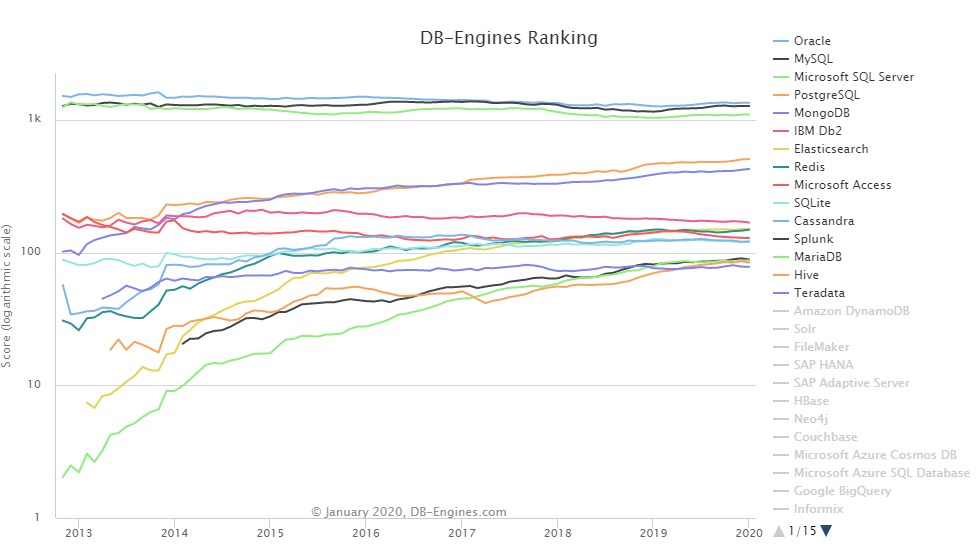
Here are the corresponding numerical data for the same TOP 10 databases, showing the change in their ranking and score compared to one month and one year ago :
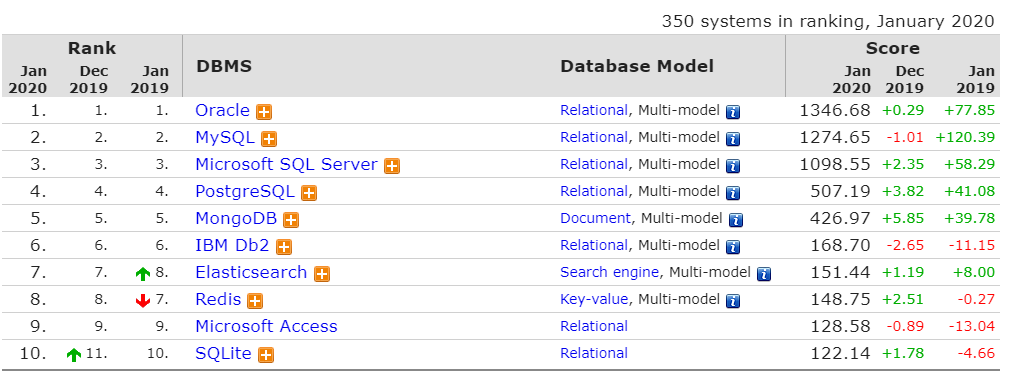
In January 2020, the most popular database engines are as follows:
Oracle (score = 1346)
MySQL (score = 1274)
Microsoft SQL Server (score = 1098)
PostgreSQL (score = 507)
MongoDB (score = 426)
IBM Db2 (score = 168)
Elasticsearch (score = 151)
Redis (score = 148)
Microsoft Access (score = 128)
SQLite (score = 122)
Some clarifications about the graphs :
It is essential to note that the vertical scale of the graphs is logarithmic, which significantly reduces the gap between lower and higher values.
For example, in January 2020, Oracle's popularity score is 1346, while PostgreSQL's score is 507. Without a logarithmic scale, the graph would be unreadable.
The horizontal scale displays values over 8 years, from 2013 to 2020.
Analysis and comparisons
In the first part of this article on the Top 10 databases, we saw a ranking of database engines by popularity, thanks to the website DB-engine.com. In this second part, we will compare commercial databases to open-source databases, study relational databases versus NoSQL databases, and more.
Popularity of Relational and NoSQL Databases, and Their Evolution Since 2013
Let's begin by examining the current popularity of relational and NoSQL databases.
In the graph below, let's focus on the following categories:
Relational DBMS
NoSQL
Columns (Wide column stores)
Document stores
Graph DBMS
Key-value Stores
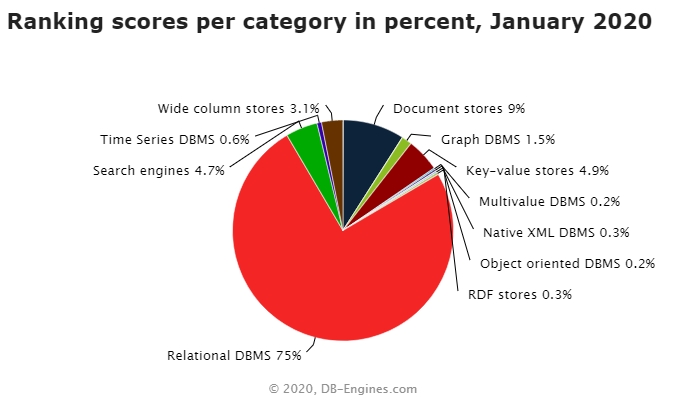
Let’s examine how the popularity of relational and NoSQL databases has evolved since January 2013, starting with a base value of 100 of each category in 2013 :
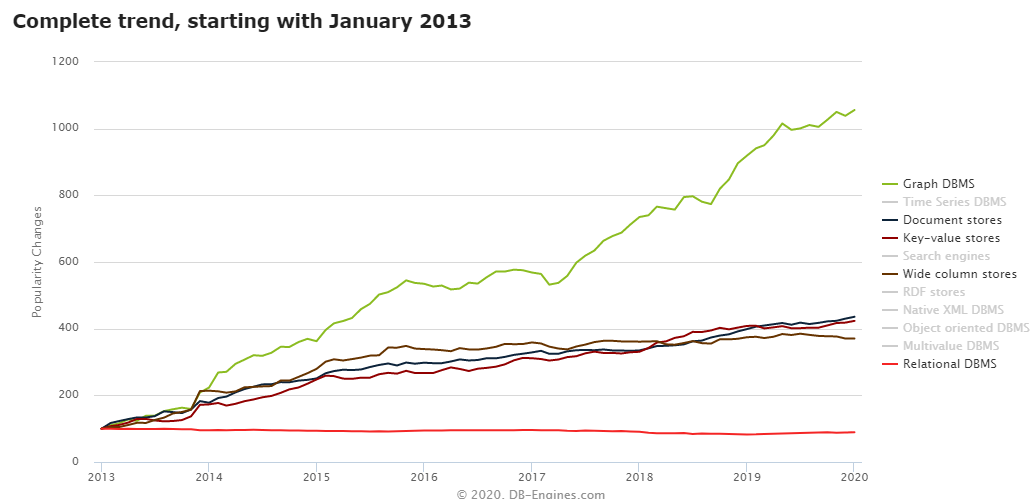
Let’s examine how the popularity of relational and NoSQL databases has changed over the past 24 months, starting with a base value of 100 of each category 24 months ago :
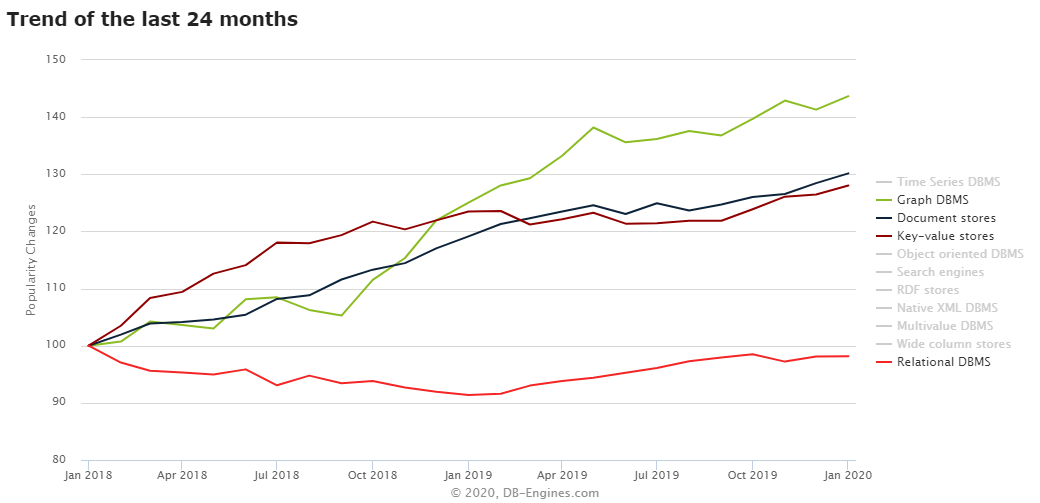
Let’s examine how the popularity of relational and NoSQL databases has changed over the past 12 months, starting with a base value of 100 of each category 12 months ago :
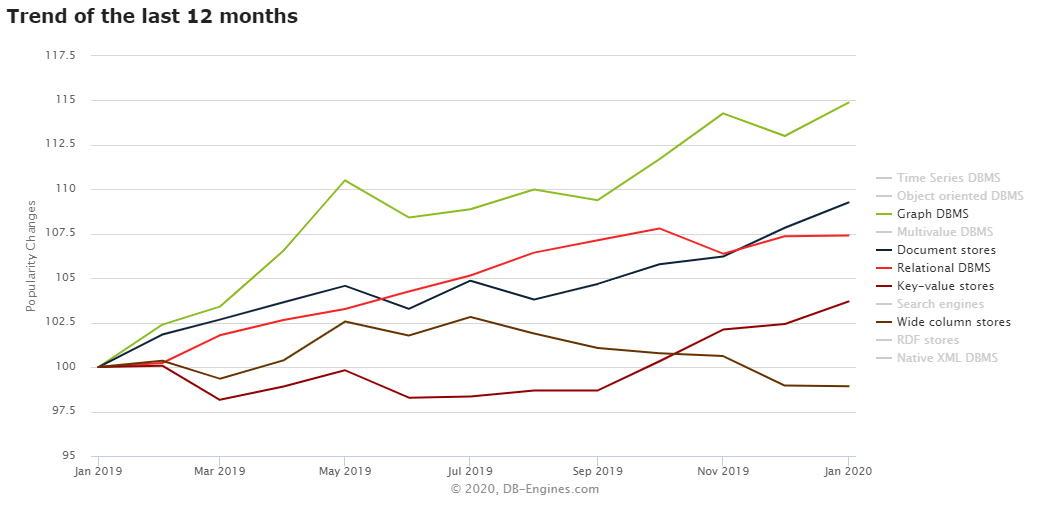
We observe a significant increase in the popularity of various types of NoSQL databases in recent years. However, these figures should not overshadow the fact that relational databases alone contribute to over 75% of the popularity index to date, across all databases, as shown in the pie chart presented earlier - though this has seen a slight decline since 2016 (from 80%).
The rise of NoSQL databases can be attributed to their strong usage in the context of real-time web applications in recent years.
Top 20 Relational Databases (Row, Column, or Hybrid Mode)
Now, let's examine the popularity of products for each of the 5 categories mentioned above.
Here are the top 20 relational databases, including both commercial and open-source options:
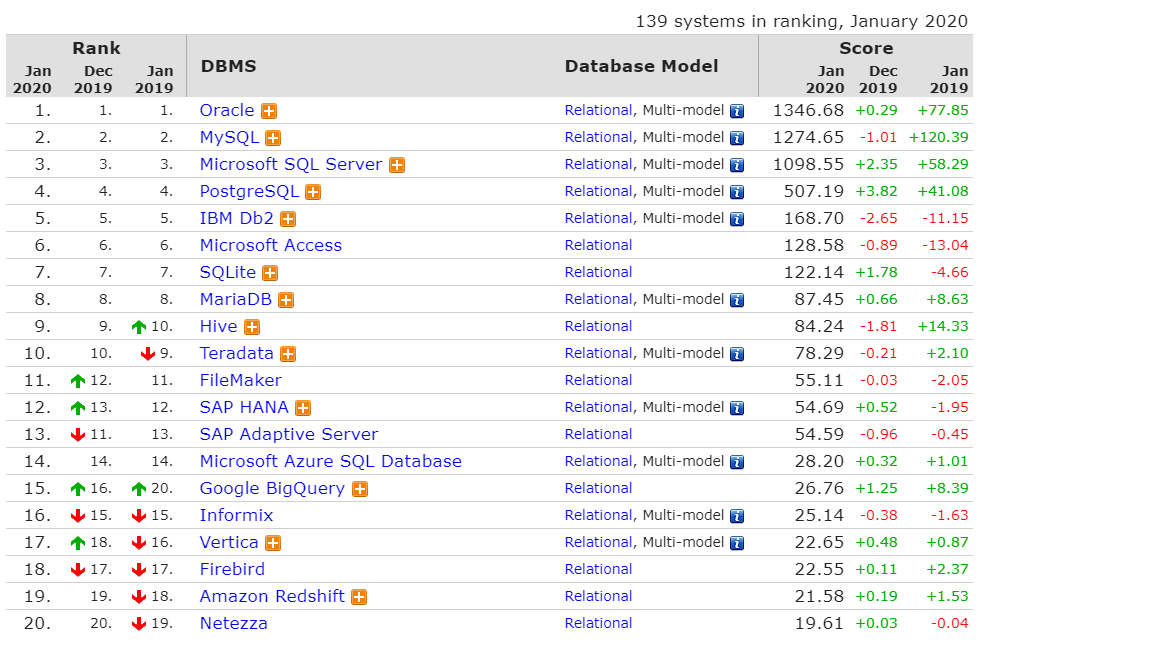
The top four entries in the ranking highlight the relatively strong performance of commercial databases (Oracle, +77.85, SQL Server, +58.29) compared to open-source databases (MySQL, +120.39, PostgreSQL, +41.08) in the most recent annual period, as opposed to previous periods when open-source databases experienced significant growth.
Let's take a look at a graph that displays the 12 commercial relational databases among the Top 20 relational databases:
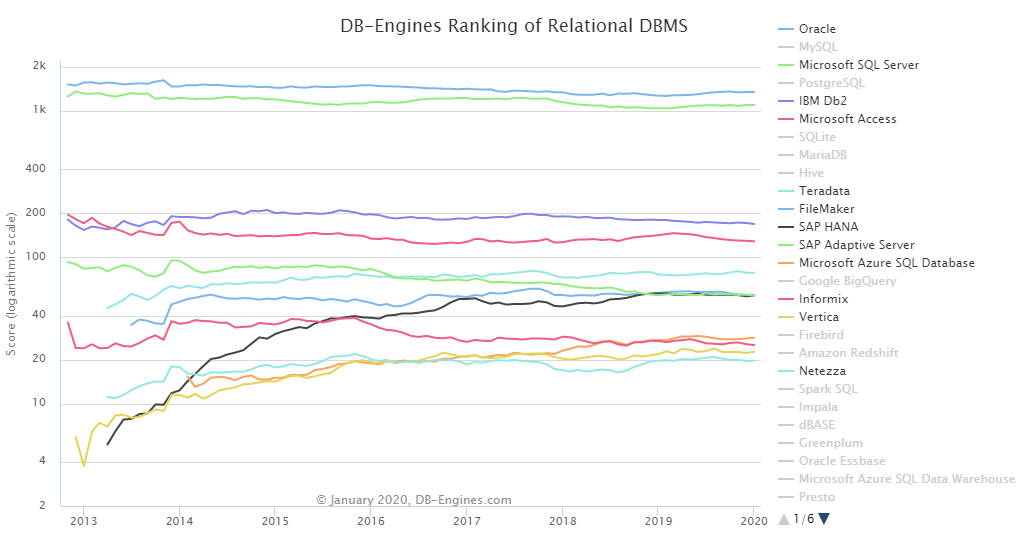
It's not surprising to see that Oracle and SQL Server lead the way among commercial databases, far ahead of DB2 and Microsoft Access.
However, there is a significant growth in:
_ Vertica: It's an optimized system for large data warehouses, and its usage has grown significantly in recent years due to the increasing number of large data warehouses.
_ SAP Hana: Introduced in 2010, SAP Hana is a database management system provided by SAP. Its growth is partly attributed to SAP's increasing use of it for hosting ERP data, replacing traditional databases like Oracle.
Now, let's take a look at a graph that shows the 8 open-source relational databases (at least in their base versions) among the Top 20 relational databases:
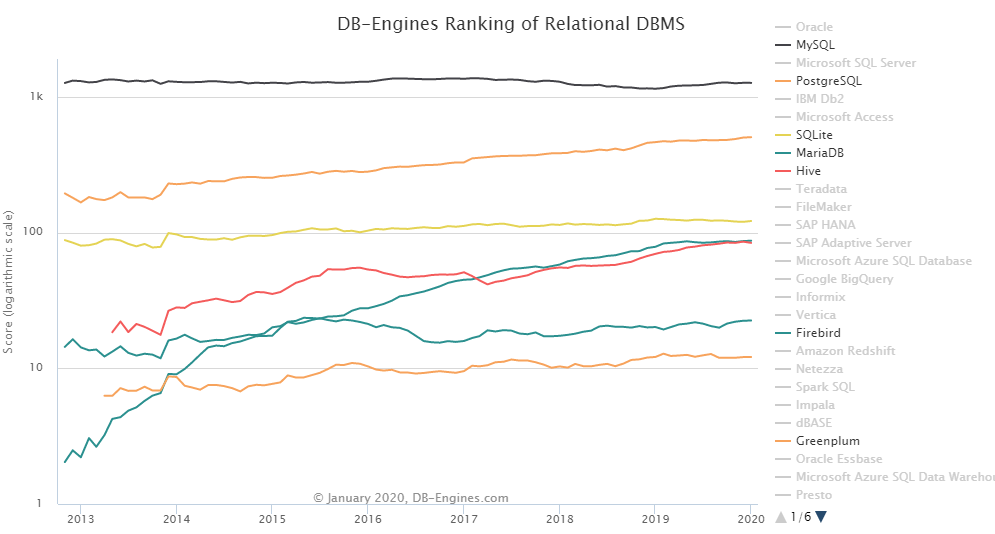
Once again, the popularity index of MySQL and PostgreSQL aligns with the market trends we observe today. MariaDB, which is derived from MySQL, is experiencing a significant rise, likely due to it being perceived as a "true" open-source DBMS, especially since MySQL is now owned by Oracle.
Top 20 Key-Value NoSQL Databases
Here is the top 20 Key-Value NoSQL databases :
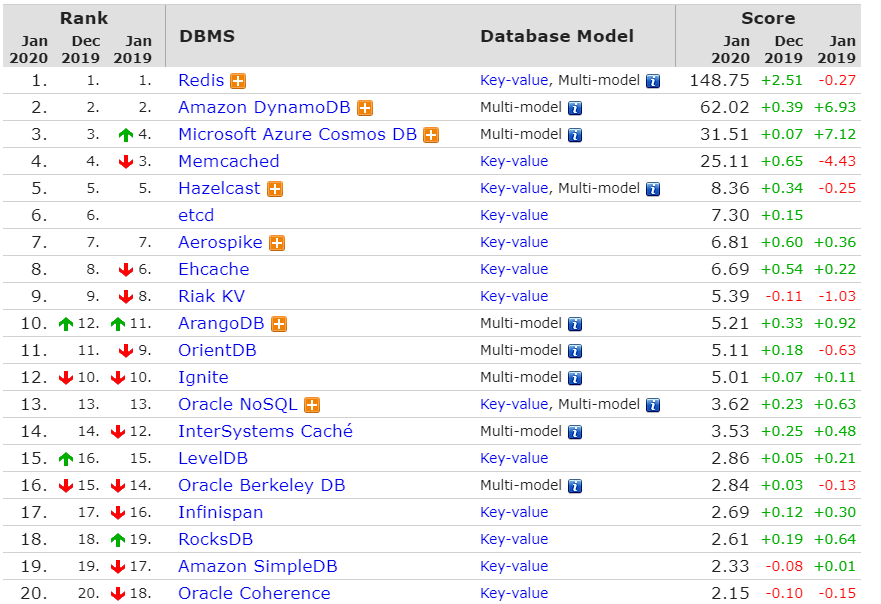
And the associated chart, for an (arbitrary) selection of products
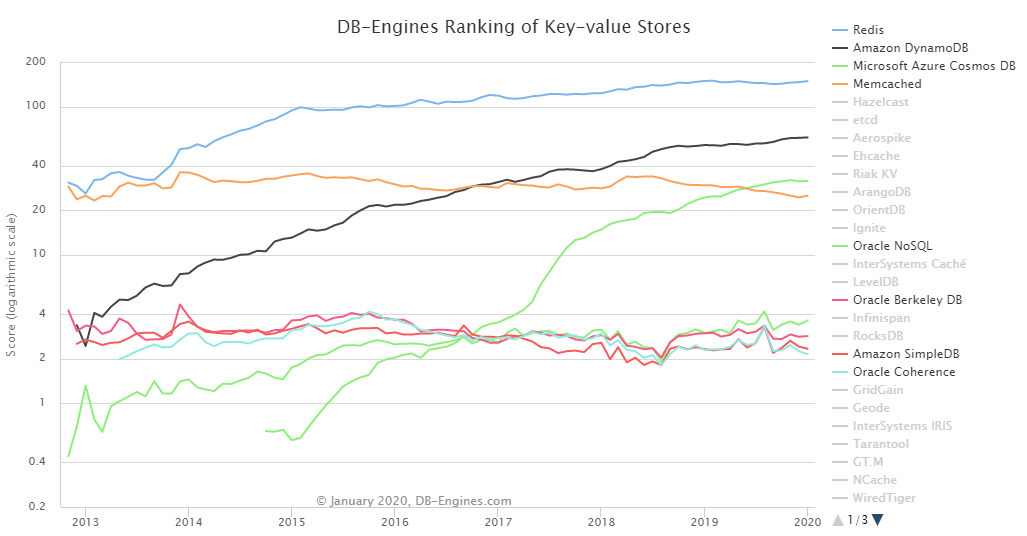
Redis and Amazon DynamoDB are notably standout in this category.
Redis is a high-performance system that relies on loading the entirety of data into memory. It has been implemented by major websites like The Guardian, GitHub, and Stack Overflow (source: Wikipedia).
Top 20 Document NoSQL Databases
Here is the top 20 Document NoSQL databases (the DB-engine website also includes some databases that are present in the Key-Value category)
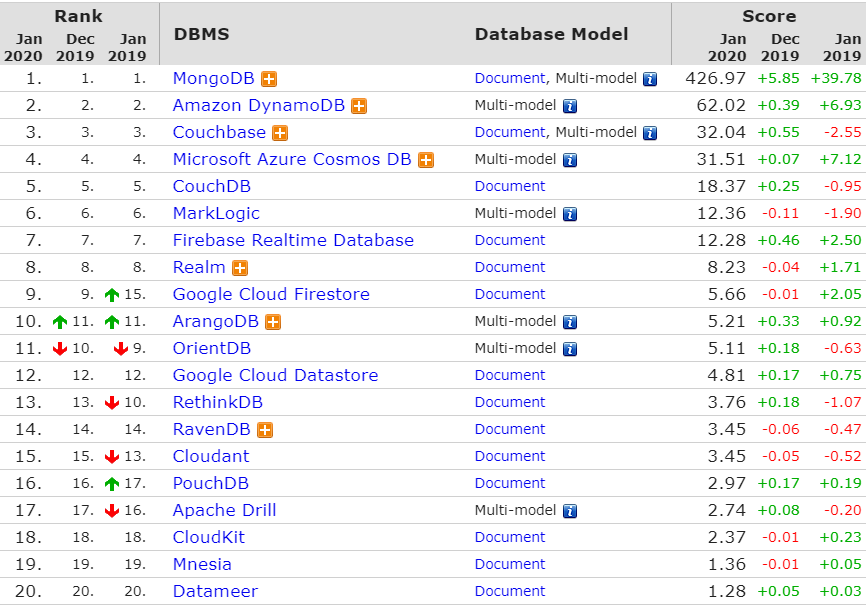
And the associated chart, for an (arbitrary) selection of products:
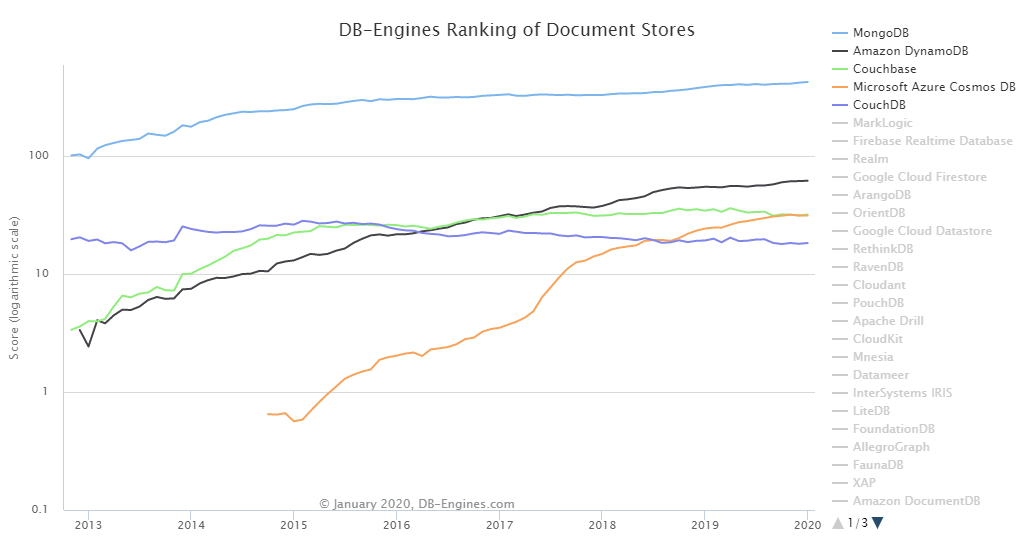
In this context, MongoDB's unquestionable supremacy is evident, and DIGORA has developed expertise in this area.
It's worth noting the significant progress of Microsoft Azure Cosmos DB.
MongoDB has been the market leader in NoSQL databases since its inception and has solidified its position. It is notably used by major websites such as eBay, Yellow Pages, and The New York Times (source: Wikipedia).
Microsoft Azure Cosmos DB is Microsoft's NoSQL solution. It is relatively new, which explains its strong growth.
Top 20 Graph NoSQL Databases
These databases are based on graphical structures and are typically suitable for social networks and similar applications. Here are the top 20 Graph-type databases (the DB-engine website also includes some multi-model databases in this category):
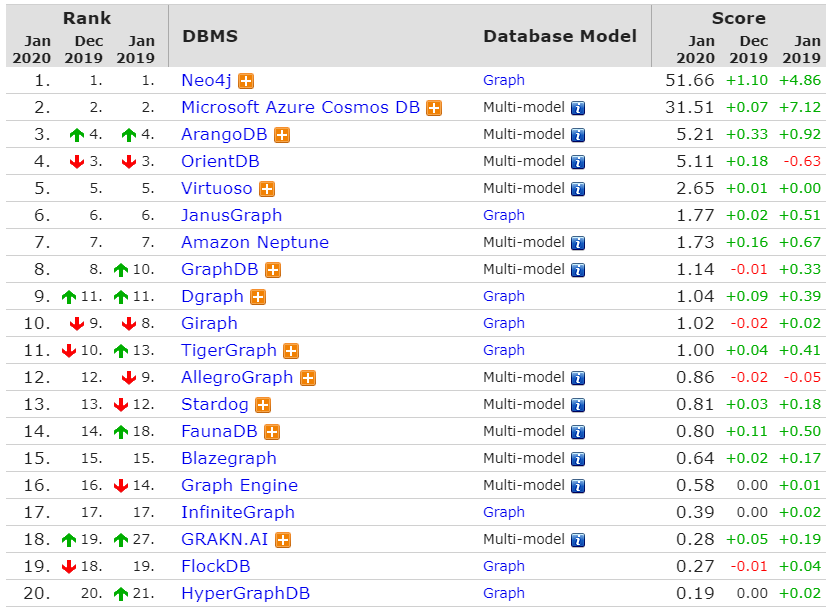
And the associated chart :
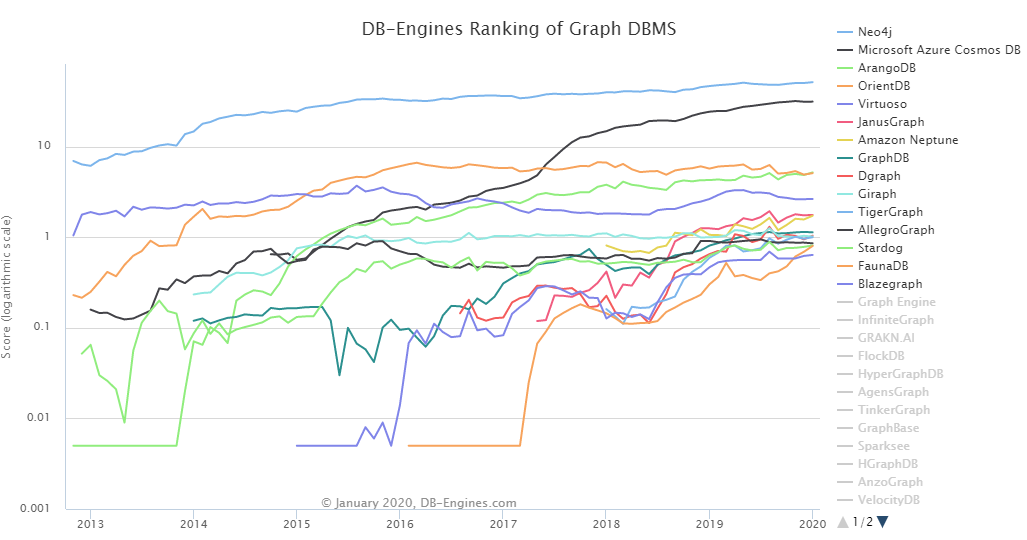
Here, we can see the dominance of Neo4j, but there's also a strong growth trend for Microsoft Azure Cosmos DB, which we've noted previously.
Neo4j's popularity can be attributed to its wide range of features, particularly well-suited for social networks, and its user-friendly approach due to the quality of documentation and tutorials.
Top 10 Wide Column NoSQL Databases
Here are the top 10 Columnar-type databases (the DB-engine website also includes one multi-model database in this category):
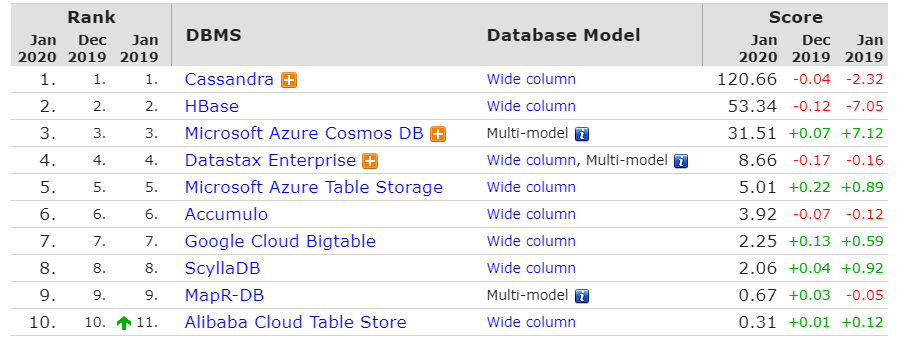
And the associated chart :
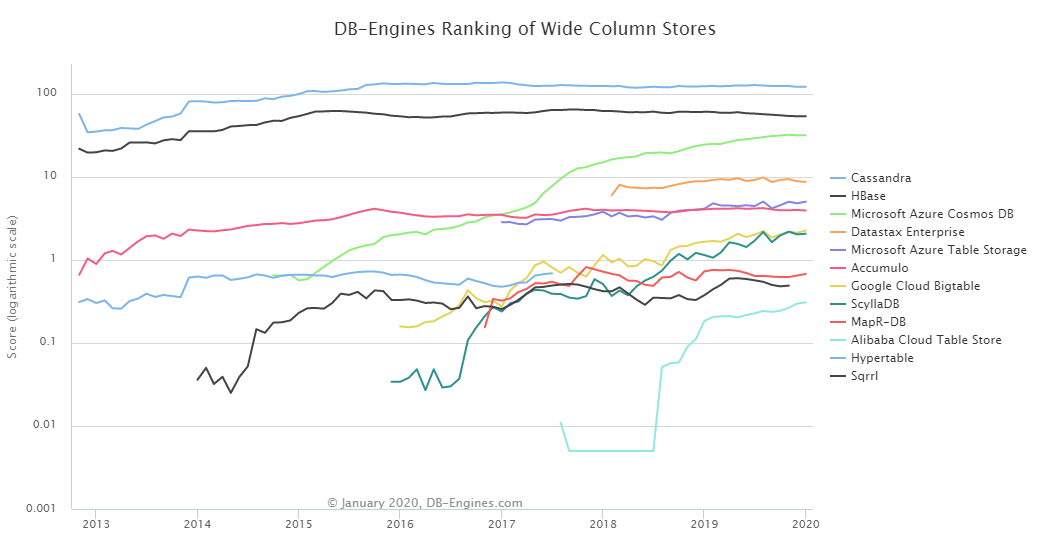
In a Wide Column-Store database, a table contains rows and columns, but unlike a typical relational database, the name and format of columns can vary from one row to another within the same table.
Here, we can see the dominance of Cassandra, on which DIGORA has developed expertise, particularly with the extensions provided by DATASTAX.
Cassandra has a significant advantage in being able to organize data in a distributed and redundant manner, which provides flexibility and robustness in case of failures.
Prominent users of Cassandra include Apple, BlackRock, CERN, Cisco's WebEx, Discord, Netflix, and more.
Top 10 Object-Oriented Databases
Here are the top 10 Object-Oriented databases :
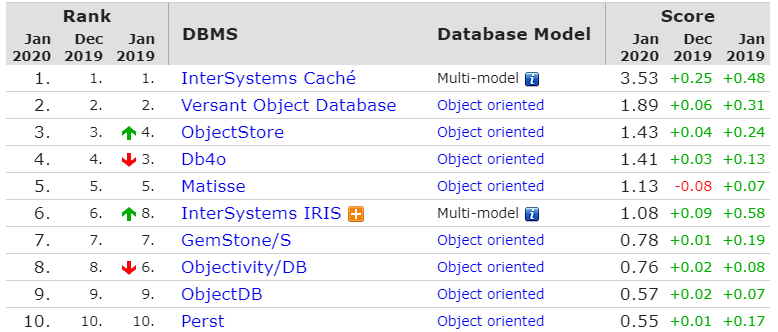
Multi-Model databases support various modeling types, as exemplified by InterSystems Caché :

And the associated chart :
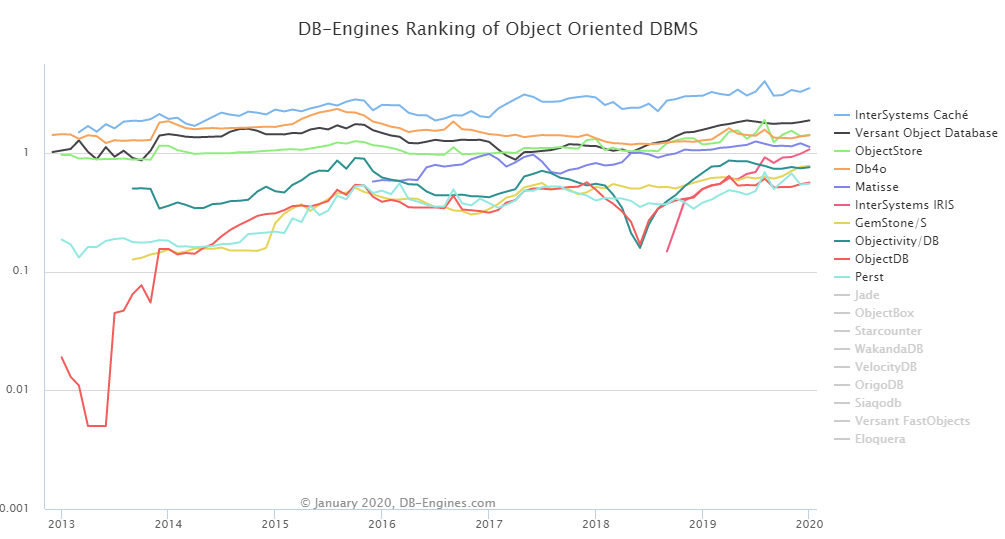
Multi-Model databases, as exemplified by InterSystems Caché, support various modeling types. In this context, we can observe the confirmed dominance of the InterSystems Caché database, as well as strong growth for the relatively recent InterSystems IRIS database.
The success of these solutions can be attributed to their multi-model nature, accommodating object-oriented databases, NoSQL key-value stores, relational database management for Caché and Iris, and document-oriented databases for Iris.
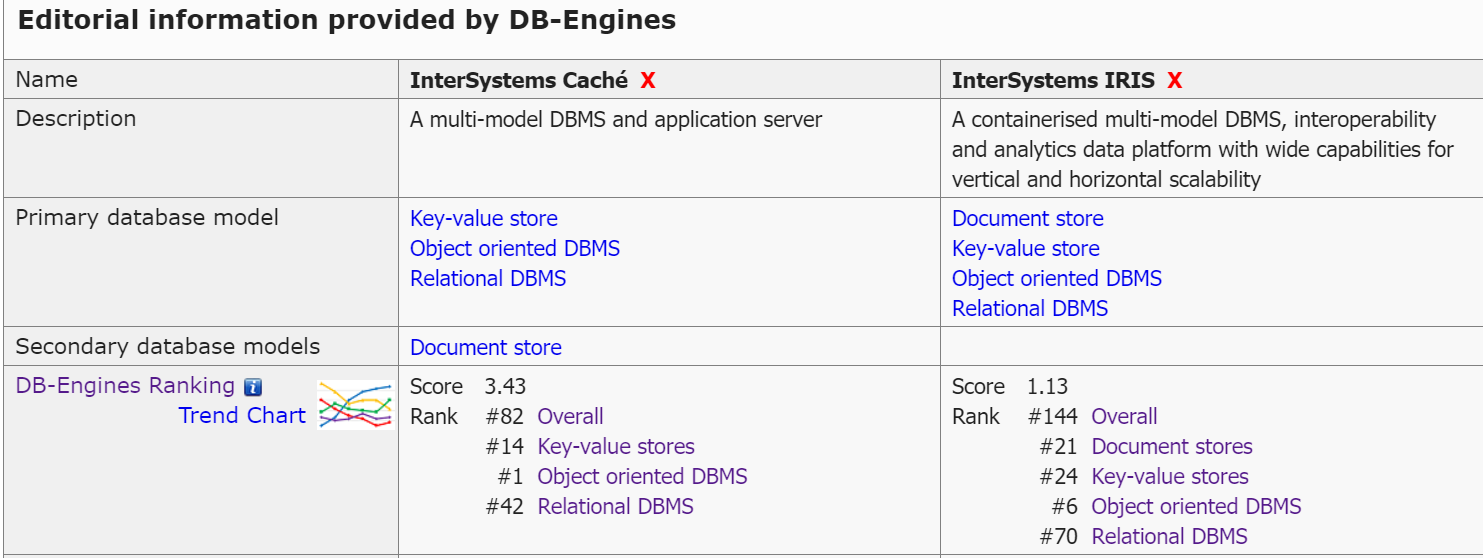
TOP 10 list of Search Engine-type databases
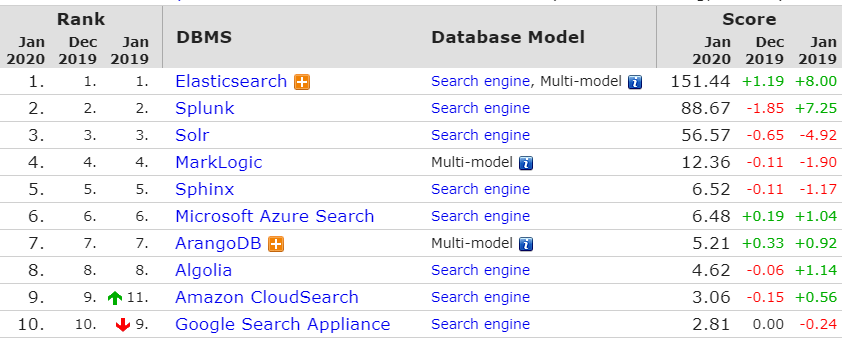
And the associated chart :
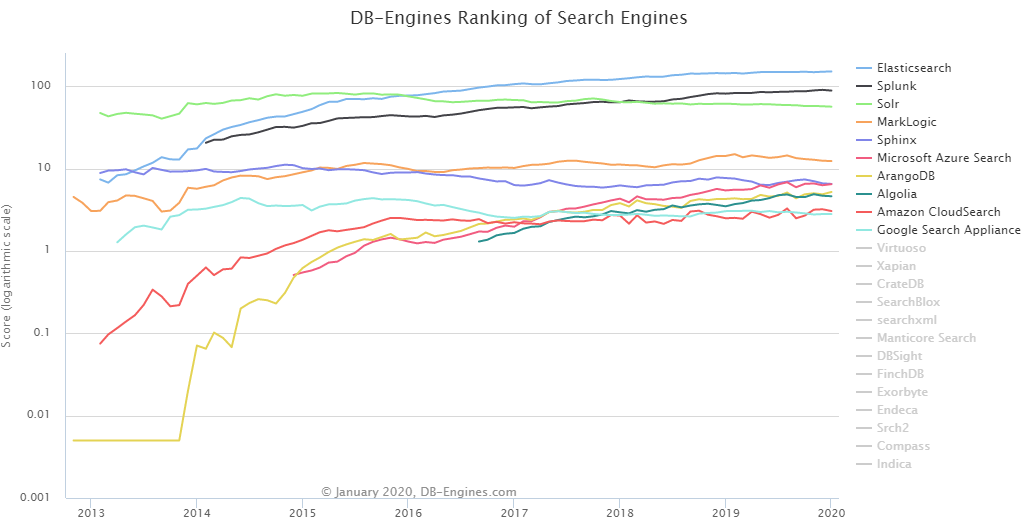
We can clearly see the significant growth of Elasticsearch in recent years, which has taken the top position in the ranking.
Elasticsearch is the most popular enterprise search server.
Elasticsearch's primary strength comes from its built-in tools for data visualization and analysis.
If you find yourself overwhelmed by all these database engines, it's a good idea to seek the assistance of a data expert to help you choose, maintain, and secure your databases.
If you need any further information or assistance, please feel free to reach out to us. We're here to help!
